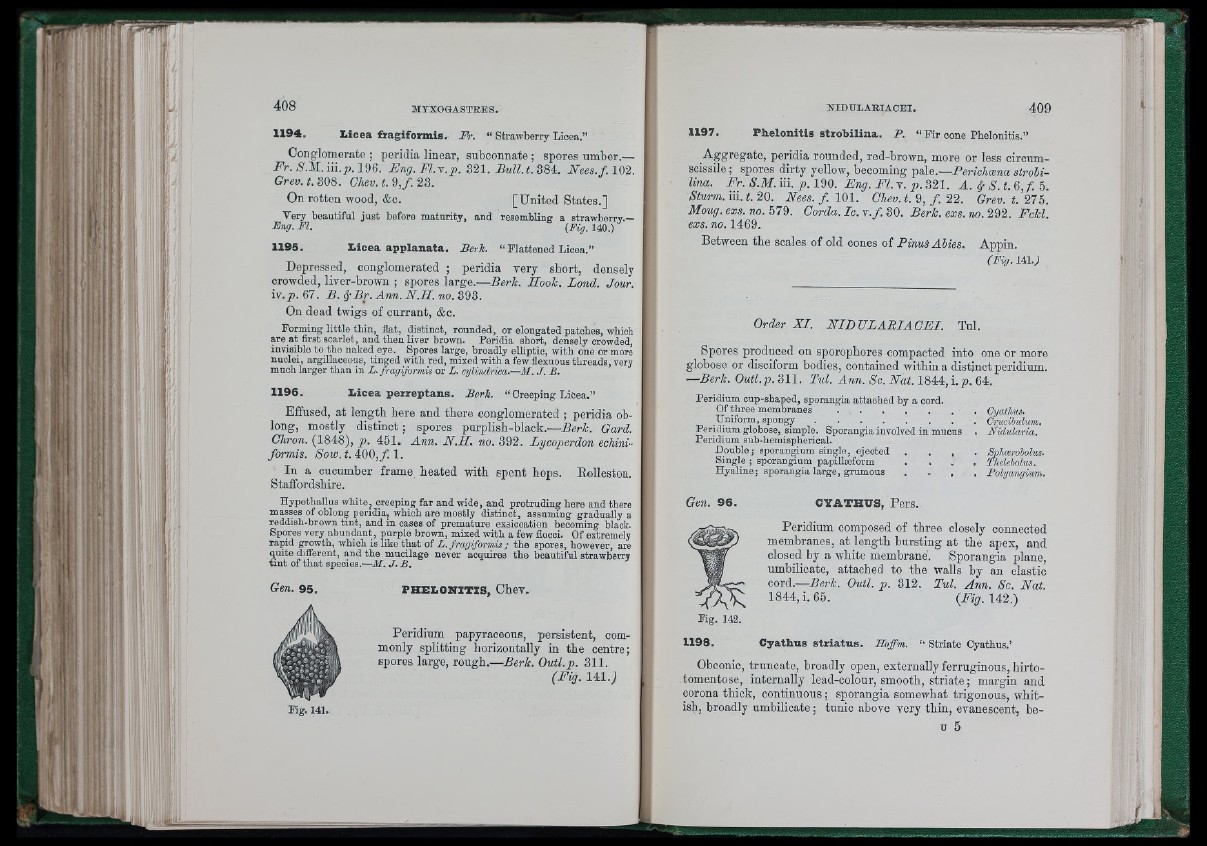
r :ï
f
'p i
1 1 9 4 . L i c e a f r a g i f o im i s . AV. “ Strawberry Licea.”
Conglomerate ; peridia linear, subconnate ; spores umber.—
Dr. N.M. iii.)». 196. Eng. F l.r .p . 321. Bull.t. 384. Nees.f. 102.
Grev. t. 308. Chev. t. 9 ,/. 23.
On rotten wood, &c. [United States.]
Very beautiful just before maturity, and resembling a strawberry.—
Bng. Fl. (pig, 140.)
11 9 5 . L ic e a a p p lan a ta .
Depressed, conglomerated
Berk. “ Flattened Licea.”
peridia very sbort, densely
crowded, liver-brown ; spores large.—Berk. Hook. Bond. Jour.
iv.)». 67. B. 4 B r.A n n . N .H . n o .393.
On dead twigs of currant, &c.
Forming little tbin, flat, distinct, rounded, or elongated patches, which
MO at first scarlet, and then liver brown. Peridia short, densely crowded,
invisible to the naked eye. Spores large, broadly elliptic, with one or more
nuclei, argillaceous, tinged with red, mixed with a few flexuous threads, very
much larger than in L. fragiformis or L. cylindrica.—M. J. B.
1 1 9 6 . L ic e a p e z z ep tan s. Berk. “ Creeping Licea.”
Effused, at length here and there conglomerated ; peridia oblong,
mostly d is tin c t; spores purplisb-black.—Berk. Gard.
Chron. (1848), p . 451. Ann. N .H . no. 392. Lycoperdon echini-
formis. Sow. t. 400, f . 1.
In a cucumber fraane heated witb spent bops. Eolleston.
Staffordshire.
Hypothallus white, creeping far and wide, and protruding here and there
masses of oblong peridia, which are mostly distinct, assnming gradually a
reddish-brown tint, and in cases of premature exsiccation becoming black.
Spores very abundant, purple brown, mixed with a few flooci. Of extremely
rapid growth, which is like that of L. fragiformis ; the spores, however, are
quite different, and the mucilage never acquires the beautiful strawberry
tin t of that species.—M. J. B.
Gen. 9 5 . FH E LO N IT IS , Cbev.
Peridium papyraceous, persistent, commonly
splitting horizontally in tbe centre;
spores large, rougb.—Berk. Outl.p. 311.
(Fig. 141.)
Fig. 141.
1197.
N I D U L A E I A C E I . 4 0 9
P h e lo n it is s tz o b ilin a . P. “ Fir cone Phelonitis.”
Aggregate, peridia rounded, red-brown, more or less circumscissile;
spores dirty yellow, becoming pale.—Perichoena strobi-
lina. Fr. S.M. ill. p. 190. Eng. Fl. v. p . 321. A . / N. t. 6, f. 5.
Sturm, iii. t. 20. Nees. f . 101. Chev. t. 9, / . 22. Grev. t. 275.
Moug. exs. no. 579. Corda. I c . r .f . 30. Berk. exs. no. 292. Fckl.
exs. no. 1469.
Between tbe scales of old cones of Pinus Abies. Appin.
(Fig. 141.)
Order X I . N ID U L A B IA C E I . Tul.
Spores produced on sporophores compacted into one or more
globose or disciform bodies, contained witbin a distinct peridium.
■—Berk. Outl. p. 311. Tul. Ann. Sc. N at. 1844, i. p. 64.
Peridinm cup-shaped, sporangia attached by a cord.
Of three m e m b r a n e s ...........................................
Uniform, s p o n g y ....................................................
Peridmm globose, simple. Sporangia involved in mucus
Peridium sub-hemisphorical.
Double; sporangium single, ejected . . ,
Single; sporangium papilleeform . . ^
Hyaline; sporangia large, grumous
Cyathus.
Crucihulum,
NîÂularia.
Sphceroholus.
Thelebolus.
Polyangium.
Gen. 9 6 . CYATHUS, Pers.
Peridium composed of three closely conneoted
membranes, at length bursting at tbe apex, and
closed by a wbite membrane. Sporangia plane,
umbilicate, attached to the walls by an elastic
cord.'—Berk. Outl. p. 312. Tul. Ann. Sc. Nat.
1844, i. 65. (Di^. 142.)
Fig. 142.
1198. Cy a th us s tz ia tu s . Hoffm. “ Striate Cyathus.’
Oboonic, truncate, broadly open, externally ferruginous, birto-
tomentose, internally lead-colour, smooth, stria te; margin and
corona tbick, continuous; sporangia somewhat trigonous, whitish,
broadly umbilicate ; tunic above very tbin, evanescent, be